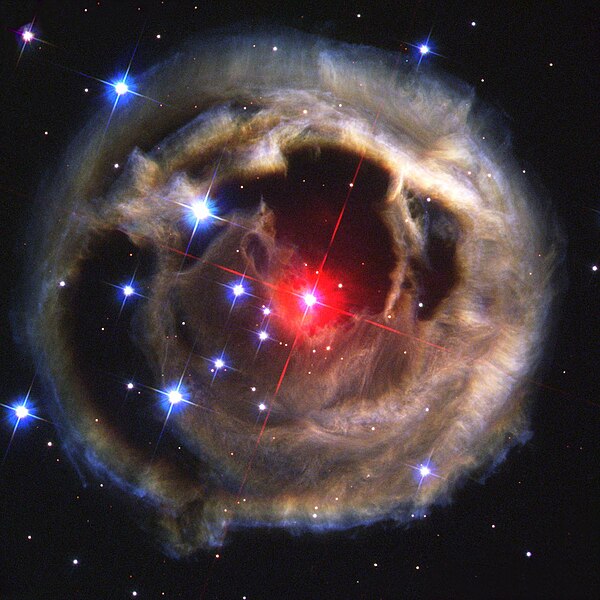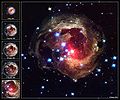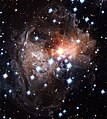ファイル:V838 Mon HST.jpg
 ウィキペディアから無料の百科事典
ウィキペディアから無料の百科事典

元のファイル (1,651 × 1,651 ピクセル、ファイルサイズ: 276キロバイト、MIME タイプ: image/jpeg)
ファイルの履歴
過去の版のファイルを表示するには、その版の日時をクリックしてください。
| 日付と時刻 | サムネイル | 寸法 | 利用者 | コメント | |
|---|---|---|---|---|---|
| 現在の版 | 2004年12月21日 (火) 06:18 |  | 1,651 × 1,651 (276キロバイト) | Evil Monkey | In January 2002, a dull star in an obscure constellation suddenly became 600,000 times more luminous than our Sun, temporarily making it the brightest star in our Milky Way galaxy. The mysterious star, called V838 Monocerotis, has long since faded back to |
ファイルの使用状況
以下の 5 ページがこのファイルを使用しています:
グローバルなファイル使用状況
以下に挙げる他のウィキがこの画像を使っています:
- af.wikipedia.org での使用状況
- ang.wikipedia.org での使用状況
- an.wikipedia.org での使用状況
- ar.wikipedia.org での使用状況
- مجرة
- مقراب هابل الفضائي
- مستخدم:Roberto Mura
- V838 وحيد القرن
- ويكيبيديا:صور مختارة/الفضاء والكون/نظرة إلى الأعلى
- بوابة:علم الفلك/صورة مختارة
- تسمية النجوم المتغيرة
- مستعر أحمر ساطع
- ويكيبيديا:ترشيحات الصور المختارة/V838 وحيد القرن
- ويكيبيديا:صورة اليوم المختارة/سبتمبر 2019
- قالب:صورة اليوم المختارة/2019-09-29
- بوابة:علم الفلك/صورة مختارة/75
- ويكيبيديا:صورة اليوم المختارة/أغسطس 2022
- قالب:صورة اليوم المختارة/2022-08-13
- ast.wikipedia.org での使用状況
- az.wikipedia.org での使用状況
- be.wikipedia.org での使用状況
- bs.wikipedia.org での使用状況
- ca.wikipedia.org での使用状況
- cs.wikipedia.org での使用状況
- cy.wikipedia.org での使用状況
- da.wikipedia.org での使用状況
- de.wikipedia.org での使用状況
- de.wikibooks.org での使用状況
- el.wikipedia.org での使用状況
- en.wikipedia.org での使用状況
このファイルのグローバル使用状況を表示する。







